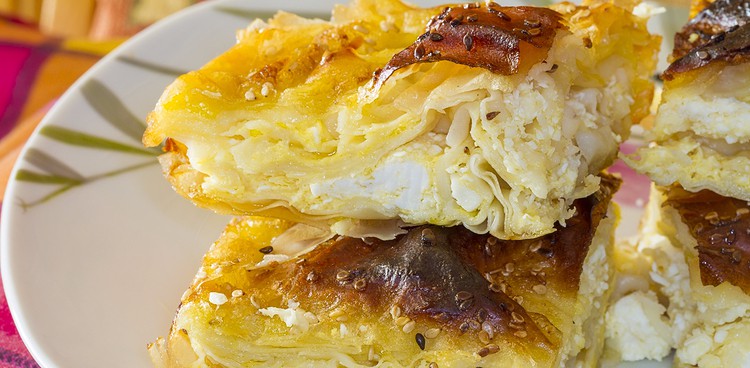
There are endless reasons to travel the world, but one always stands out: food. Get Cultured takes you on a journey through cheesy dishes from different cultures (heyo), exploring how they came to be, what makes them significant, where you can find the real deal, and how you can make your own.
Missed last week’s post on poutine? Check it out!
Tiropita, a hand pie filled with cheese and egg, is a Greek staple. Flaky, decadent, and—best of all—not too hard to find or make, its cheesy center makes it impossible not to get one’s Greek on.
Before we get to down to the tiropita nitty-gritty, let’s hop across the Ionian Sea to Italy and Cato the Elder, best known for his Latin-centric attitude, anti-Hellenic policies, and eternally quoted assertion that Carthage must be destroyed. Also known as Cato the Censor, he preached against luxury and freedom for women. Fortunately, however, he also contributed something less, um… curmudgeonly to the history books: The leading Roman expert on all things grain-related, he recorded the surviving recipe for placenta (pronounced pla-KEN-tah—don’t worry!).
Placenta consists of layers of thin dough interspersed among a filling of ricotta, honey, and bay leaves. Cato’s recipe in On Agriculture is surprisingly detailed and specific, instructing Roman restaurateurs to moisten and knead two pounds of flour for the outer crust. That’s all well and good. Macerating sheep’s cheese in water—taking care to change the water three times throughout—is a little weirder, but we 21st-century-dwellers can just use ricotta. Cato continues with instructions to take the cheese from the bowl by the handful, drying it thoroughly, and then knead and sift it once more (I repeat—let’s just use ricotta, please). Add honey (good honey, he specifies), layer it with tracta (strips of thin dough, conceptually not unlike lasagna), and throw it on some hot coals (I may be paraphrasing). The result is a sweet, flaky, ricotta-and-honey cake.

Photo courtesy of Pass the Garum
The Roman gods, a notoriously hungry bunch, were often well furnished with offerings of placenta. Cato’s recipe, as such, makes a ridiculous portion. Two pounds of flour. Fourteen pounds of cheese. Four and a half pounds of honey. If he wasn’t serving this up to ol’ Jupiter, we can be pretty certain he had leftovers for days.
“Ahem,” you say, “I thought this was the story of tiropita, not placenta.” Well, dear reader, you are absolutely right. Do these ingredients sound familiar? Flour? Cheese? Layers of dough? Tiropita is widely thought to have descended from placenta, despite the fairly significant difference in taste—placenta, drizzled in yet more honey after the honey-ricotta mixture, is very sweet, while tiropita is cheesy and umami. Cato would be pleased—a Roman staple passed down to the Greeks, rather than vice versa.
Tiropita, which literally translates to “cheese pie” (tiro means cheese; pita means pie), traditionally consists of phyllo-wrapped feta. Phyllo, the Greek word for “leaf,” is a thinner-than-paper dough that gets layered upon itself several times before being spread with cheese. Because feta is crumbly, tiropita recipes call for eggs and other cheeses (often ricotta, parmesan, or cottage cheese) to mix it with. Depending on where you go, you might find it in small triangles—a dollop of the cheese mixture having been dropped onto a phyllo strip folded like an American flag—or in rectangles cut from a larger pie.

Photo Credit: Mariontxa | Shutterstock
Greece, after all, loves its pies. As you float from café to café, you’re apt to find many variations on this cheesy staple, from the oft-Americanized spanakopita (spinach pie) to milk pie, mushroom pie, and meat pie. The best way to enjoy tiropita or any of its variations would doubtless be to find a Greek grandmother to make you a home-cooked μεσημεριανό (lunch), but that may be more difficult to orchestrate than finding a great καφενείο (cafe). So, between gazing upon the majestic Acropolis and sipping on some ouzo, where can the best tiropita be found?
Many say the answer is a shop called Ariston (or Aριστον, which means “excellent”), tucked behind Syntagma Square in Athens. Around since 1910, Ariston is still run by the same family that set up shop all those years ago, and it serves Athenians and visitors alike. Ariston’s appeal lies not just in its quality but also in its variety—on any given day, there are at least fifteen different kinds of pie available, so it’s worth a visit for at least fifteen reasons. Tiropita is so ubiquitous in Athens, though, that even if you don’t get a chance to swing by Ariston, you’ll be hard-pressed not to find a delicious one somewhere else.
If all else fails, bust out the phyllo dough and get your Cato the Elder on. And for a veg-ified version, these herbed feta and cheddar hand pies are a delicious alternative.
Click here to read about the next cheesy dish on Get Cultured‘s roster: raclette!
Feature Photo Credit: Anastasios71 | Shutterstock



